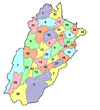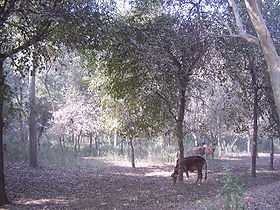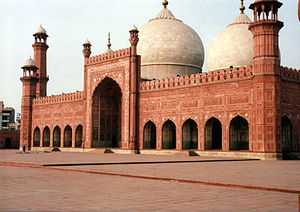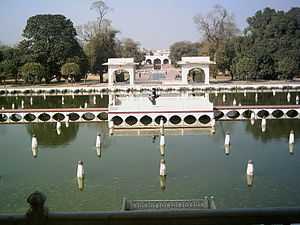Punjab, Pakistan
| Punjab پنجاب | |||
|---|---|---|---|
| Province | |||
 Chenab River, Lahore Fort, Nankana Sahib, Faisalabad, Noor Mahal – Bahawalpur, Masjid Wazir Khan – Lahore. | |||
| |||
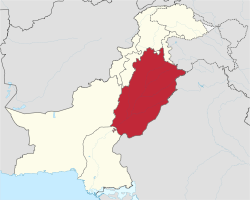 | |||
_Divisions.png) | |||
| Coordinates: 31°N 72°E / 31°N 72°ECoordinates: 31°N 72°E / 31°N 72°E | |||
| Country | Pakistan | ||
| Established | 1 July 1970 | ||
| Capital | Lahore | ||
| Largest city | Lahore | ||
| Government | |||
| • Type | Province | ||
| • Body | Provincial Assembly | ||
| • Governor | Chaudhary Muhammad Sarwar(PML N) | ||
| • Chief Minister | Shahbaz Sharif (PML-N) | ||
| Area | |||
| • Total | 205,344 km2 (79,284 sq mi) | ||
| Population (2013)[2] | |||
| • Total | 101,000,000 | ||
| • Density | 490/km2 (1,300/sq mi) | ||
| http://energy.punjab.gov.pk/opportunities_in_punjab.html | |||
| Time zone | PKT (UTC+5) | ||
| Main Language(s) | Other languages: Saraiki, Potohari, Hindko, Jhangochi, Mewati, Baluchi | ||
| Assembly seats | 371[3] | ||
| Districts | 36 | ||
| Tehsils/Towns | 127 | ||
| Website | punjab.gov.pk Punjab Portal | ||
Punjab (Urdu: پنجاب, Shahmukhī Punjabi: پنجاب, panj-āb, "five waters": ![]() listen (help·info)), also spelled Panjab, is the most developed and populous province of Pakistan with approximately 56% of the country's total population.[4][5][6] Lahore is the provincial capital and Punjab's main cultural, historical, administrative and economic center.[7]
listen (help·info)), also spelled Panjab, is the most developed and populous province of Pakistan with approximately 56% of the country's total population.[4][5][6] Lahore is the provincial capital and Punjab's main cultural, historical, administrative and economic center.[7]
Etymology
The word Punjab is a xenonym/exonym that was formally introduced by the Mughals in the early 17th Century CE. It is a combination of the Persian words punj (five) and āb (water), thus the (land of) five rivers.[8] The five rivers are the tributaries of the Indus River namely Chenab, Jhelum, Ravi, Beas and Sutlej. From the Himalayas they all end up in the down-stream of Panjnad, eventually to the Arabian Sea. Sometimes, in English, there can be a definite article before the name i.e. the Punjab.[9] The name is also sometimes spelt as Panjab or Panjaab or Punjaab.
In the Rigveda, the sacred text of Vedism, the Punjab region is associated with the ancient Sapta Sindhu, the Land of Seven Rivers, whilst the later Greeks referred to Punjab as Pentapotamia, an inland delta of five converging rivers.[10] The British used to call Punjab "Our Prussia."
Geography
Punjab is Pakistan's second largest province in terms of Land area at 205,344 km2 (79,284 sq mi) after Balochistan and is located at the north western edge of the geologic Indian plate in South Asia. The province is bordered by Kashmir (Azad Kashmir, Pakistan and Jammu and Kashmir, India) to the north-east, the Indian states of Punjab and Rajasthan to the east, the Pakistani province of Sindh to the south, the province of Balochistan to the southwest, the province of Khyber Pakhtunkhwa to the west, and the Islamabad Capital Territory to the north.
The capital and largest city is Lahore which was the historical capital of the wider Punjab region. Other important cities include Faisalabad, Rawalpindi, Gujranwala, Multan, Sialkot, Bahawalpur, Sargodha, Gujrat, Sheikhupura and Jhelum. Undivided Punjab is home to six rivers, of which five flow through Pakistani Punjab. From west to east, these are: the Indus, Jhelum, Beas, Chenab, Ravi and Sutlej. Nearly 60% of Pakistan's population lives in the Punjab. It is the nation's only province that touches every other province; it also surrounds the federal enclave of the national capital city at Islamabad.This geographical position strongly influence Punjab's outlook on National affairs and induces in Punjab a keen awareness of the problems of the Pakistan's other important provinces and territories. In the acronym P-A-K-I-S-T-A-N, the P is for PUNJAB.
The province is a mainly a fertile region along the river valleys, while sparse deserts can be found near the border with Rajasthan and the Sulaiman Range. The region contains the Thal and Cholistan deserts. The Indus River and its many tributaries traverse the Punjab from north to south.
The landscape is amongst the most heavily irrigated on earth and canals can be found throughout the province. Weather extremes are notable from the hot and barren south to the cool hills of the north. The foothills of the Himalayas are found in the extreme north as well.
Language
- For more information, see Punjabi dialects.
The main language of the province is Punjabi.[11] The various Punjabi dialects spoken include:

- Majhi or Standard (Majority)
- Pothohari/Panjistani (Rawalpindi and Jehlum's Districts people)
- Pahari (Tehsil Muree, Kotli sattian & AJK's people)
- Dhani (Chakwal district's people)
- Shapuri (Sargodha division's people)
- Jhangochi (Khanewal and Jhang District's people)
- Jangli/Rachnavi (Sahiwal Distrct's people)
- Chenavari(Tehsil Athara Tehsil Jhang's people)
- Thalochi (Bhakkar,Layyah and Muzzaffargarh District's people)
- Hindko (Hazara Division's people living in Punjab areas)
- Chhachi (Attock Tehsil's people)
- Jandali (Jand Tehsil and Mianwali district's people)
- Multani/Saraiki (Multan and Lodhran districts people)
- Derawali (Rajanpur,Dera Ghazi Khan districts people)
- Riasti (Bahawalpur Lodhran and Rahim Yar Khan districts people)
- Ghebi (Pindi Gheb Tehsil's people)
- Dogri/Darhab (Jammu and Narowal district's people)
- mevati (Lahore, Kasur and Narowal districts's people)
The dialects spoken in different regions of the land have a common vocabulary and a shared heritage. In addition to the Punjabis, the province is also home to other smaller ethnic groups
- Urdu being the national language is spoken and understood.
- English is also understood and spoken by a sizable segment of the educated population.
- Minority Languages spoken by people of different parts of Pakistan and Afghan refugees (Pashto,Sindhi,Baluchi, Brahvi,Kashmiri, Shina, Balti, Khower, Burshiski, Rangri and Dari)
History
Ancient history

Punjab during Mahabharata times was known as Panchanada.[12][13] Punjab was part of the Indus Valley Civilization, more than 4000 years old.[14] The main site of the Indus Valley Civilization in Punjab was the city of Harrapa. The Indus Valley Civilization spanned much of what is today Pakistan and eventually evolved into the Indo-Aryan civilization. The arrival of the Indo-Aryans led to the flourishing of the Vedic civilization along the length of the Indus River. This civilization shaped subsequent cultures in South Asia and Afghanistan. Although the archaeological site at Harappa was partially damaged in 1857 when engineers constructing the Lahore-Multan railroad used brick from the Harappa ruins for track ballast, an abundance of artifacts have nevertheless been found. Punjab was part of the great ancient empires including the Gandhara Mahajanapadas, Achaemenids, Macedonians, Mauryas, Kushans, Guptas and Hindu Shahi. Agriculture flourished and trading cities (such as Multan and Lahore) grew in wealth.

Due to its location, the Punjab region came under constant attack and influence from the west. Invaded by the Persians, Greeks, Kushans, Scythians, Turks, and Afghans, Punjab witnessed centuries of foreign invasions. The city of Taxila, founded by son of Taksh the son Bharat who was the brother of Ram. It was reputed to house the oldest university in the world[citation needed], Takshashila University, one of the teachers was the great Vedic thinker and politician Chanakya. Taxila was a great centre of learning and intellectual discussion during the Maurya Empire. It is a UN World Heritage site, valued for its archaeological and religious history.
Central Asian, Greek, and Persian Empires

The Sultan is to the right, shaking the hand of the sheykh, with Ayaz standing behind him. Mahmud of Ghazni appointed Malik Ayaz as the ruler of Lahore, Punjab during the Ghaznavid era.
The northwestern part of the South Asia, including Punjab, was repeatedly invaded or conquered by various foreign empires, such as those of Tamerlane, Alexander the Great and Genghis Khan. Having conquered Drangiana, Arachosia, Gedrosia and Seistan in ten days, Alexander crossed the Hindu Kush and was thus fully informed of the magnificence of the country and its riches in gold, gems and pearls. However, Alexander had to encounter and reduce the tribes on the border of Punjab before entering the luxuriant plains. Having taken a northeasterly direction, he marched against the Aspii (mountaineers), who offered vigorous resistance, but were subdued. Alexander then marched through Ghazni, blockaded Magassa, and then marched to Ora and Bazira. Turning to the northeast, Alexander marched to Pucela, the capital of the district now known as Pakhli. He entered Western Punjab, where the ancient city of Nysa (at the site of modern day Mong) was situated. A coalition was formed against Alexander by the Cathians, the people of Multan, who were very skillful in war. Alexander invested many troops, eventually killing seventeen thousand Cathians in this battle, and the city of Sagala (present-day Sialkot) was razed to the ground. Alexander left Punjab in 326 B.C. and took his army to Persia and Susa.
Arrival of Islam

The Punjabis followed a diverse plethora of faiths, mainly comprising Hindus, when the Muslim Umayyad army led by Muhammad bin Qasim conquered Sindh and Southern Punjab in 712, by defeating Raja Dahir. The Umayyad Caliphate was the second Islamic caliphate established after the death of the Prophet Muhammad. It was ruled by the Umayyad dynasty, whose name derives from Umayya ibn Abd Shams, the great-grandfather of the first Umayyad caliph. Although the Umayyad family originally came from the city of Mecca, their capital was Damascus. Muhammad bin Qasim was the first to bring message of Islam to the population of Punjab. Over the next millennium Punjab was part of Muslim Empires consisting of Afghans, Pashtoon, and Turkic in cooperation with local Punjabi tribes and others, which facilitated a millennium long Islamic dominance across South Asia and with its peak during large parts of the Mughal Empire . During the reign of Mahmud of Ghazni, the province became an important centre with Lahore as its second capital of the Ghaznavid Empire based out of Afghanistan.
Mughal Empire

The Mughals controlled the region from 1524 until around 1739 and would also lavish the province with building projects such as the Shalimar Gardens and the Badshahi Mosque, both situated in Lahore. Muslim soldiers, traders, architects, theologians and Sufis flocked from the rest of the Muslim world to the Islamic Sultanate in South Asia and some may have settled in the Punjab. Following the decline of the Mughals, the Shah of Iran and founder of the Afsharid dynasty in Persia, Nader Shah crossed the Indus and sacked the province in 1739. Later, the Afghan conqueror Ahmad Shah Durrani, incidentally born in Panjab, in the city of Multan made the Punjab a part of his Durrani Empire lasting until 1762.
Afghan Empire

The founder of Afghanistan, Ahmad Shah Durrani, an ethnic Pashtun (Afghan) established the first united Afghan Kingdom (Greater Afghanistan) that during its greatest extent included modern-day Afghanistan, some western fringes of Punjab and northeastern Iran. Many ethnic Afghan or Pashtun tribes have made Pakistan's Punjab their home over the centuries. These tribes include the Khugyanis known as Khakwanis, Alizais, Tareens, Durranis, Mullazais, Niazis, Khattaks, yousafzais, Sadozais, tahirkheli, Utmanzais, bangash, mashwani, Lodhis, Kakars, Kakazais, and Barakzais, to name a few.
Maratha Empire

The Millennium long period of Muslim Empires were coming to an end, and a turbulent period would follow. In 1758, the general of the Hindu Maratha Empire, Raghunath Rao invaded Lahore and Attock.Timur Shah Durraniwho was the son and viceroy of Ahmad Shah Abdali and was already weakened by Sikh army, and was drove out of Punjab with the important and necessary help of Sikhs. Lahore, Multan, Dera Ghazi Khan, Kashmir and other subahs on the south and eastern side of Peshawar, were under the Maratha rule for the most part.[15] In Punjab and Kashmir, the Marathas were now major players.[16][17] The Third Battle of Panipat took place on 1761, Ahmad Shah Abdali invaded the Maratha territory of Punjab and captured remnants of the Maratha Empire in Punjab and Kashmir regions and re-consolidated control over them.[18]
Sikh Empire

In mid fifteenth century, the religion of Sikhism was born. During the Mughal empire, due to the strong and righteous approach many Hindus increasingly adopted Sikhism. These became a formidable military force against the Mughals and later against the Afghan Empire. After fighting Ahmad Shah Durrani in the later eighteenth century, the Sikhs took control of Punjab and managed to establish the Sikh Empire under Maharaja Ranjit Singh, which lasted from 1799 to 1849. The capital of Ranjit Singh's empire was Lahore, and the empire also extended into Afghanistan and Kashmir.
British Empire
Maharaja Ranjit Singh's death in the summer of 1839 brought political chaos and the subsequent battles of succession and the bloody infighting between the factions at court weakened the state. Relationships with neighbouring British territories then broke down, starting the First Anglo-Sikh War; this led to a British official being resident in Lahore and the annexation in 1849 of territory south of the Satluj to British India. After the Second Anglo-Sikh War in 1849, the Sikh Empire became the last territory to be merged into British India. Some parts of Pakistani Punjab also served as the centre of resistance in the Indian Rebellion of 1857.
Independence
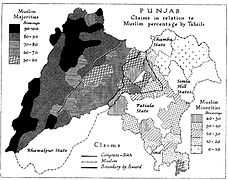
Migration between India and Pakistan was continuous and traces back before the partition. By the 1900s Western Punjab was predominantly Muslim and supported the Muslim League and Pakistan Movement. After the independence of Pakistan in 1947, the minority Hindus and Sikhs migrated to India while Muslim refugees from India settled in the Western Punjab and across Pakistan.[19]
In 1947 the Punjab province of British India was divided along religious lines into West Punjab and East Punjab. Western Punjab was assimilated into the new country of Pakistan, while East Punjab became a part of modern-day India. This led to massive rioting as both sides committed atrocities against fleeing refugees.
Punjab (Pakistan), which once formed a major region of British Punjab, was home to a large minority population of Punjabi Sikhs and Hindus up to 1947 apart from the Muslim majority.[20]
At the time of independence in 1947, due to the ensuing horrendous exchange of populations, the Punjabi Sikhs and Hindus migrated to India[21] Punjabi Muslims were uprooted similarly from their homes in East Punjab which now forms part of India.[22]
Recent history
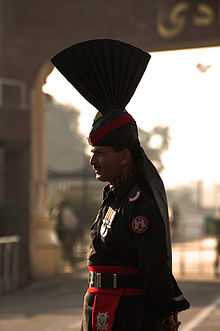
Since the 1950s, Punjab industrialized rapidly. New factories were established in Lahore, Multan, Gujrat, Gujranwala, Sialkot and Wah. In the 1960s the new city of Islamabad was built near Rawalpindi.
Agriculture continues to be the largest sector of Punjab's economy. The province is the breadbasket of the country as well as home to the largest ethnic group in Pakistan, the Punjabis. Unlike neighbouring India, there was no large-scale redistribution of agricultural land. As a result most rural areas are dominated by a small set of feudalistic land-owning families.
In the 1950s there was tension between the eastern and western halves of Pakistan. In order to address the situation, a new formula resulted in the abolition of the province status for Punjab in 1955. It was merged into a single province West Pakistan. In 1972, after East Pakistan seceded and became Bangladesh, Punjab again became a province.
Punjab witnessed major battles between the armies of India and Pakistan in the wars of 1965 and 1971. Since the 1990s Punjab hosted several key sites of Pakistan's nuclear program such as Kahuta. It also hosts major military bases such as at Sargodha and Rawalpindi. The peace process between India and Pakistan, which began in earnest in 2004, has helped pacify the situation. Trade and people-to-people contacts through the Wagah border are now starting to become common. Indian Sikh pilgrims visit holy sites such as Nankana Sahib.
Starting in the 1980s, large numbers of Punjabis migrated to the Middle East, Britain, Spain, Canada and the United States for economic opportunities, forming the large Punjabi diaspora. Business and cultural ties between the United States and Punjab are growing.
Climate

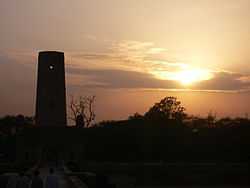
Most areas in Punjab experience extreme weather with foggy winters, often accompanied by rain. By mid-February the temperature begins to rise; springtime weather continues until mid-April, when the summer heat sets in.

The onset of the southwest monsoon is anticipated to reach Punjab by May, but since the early 1970s the weather pattern has been irregular. The spring monsoon has either skipped over the area or has caused it to rain so hard that floods have resulted. June and July are oppressively hot. Although official estimates rarely place the temperature above 46°C, newspaper sources claim that it reaches 51°C and regularly carry reports about people who have succumbed to the heat. Heat records were broken in Multan in June 1993, when the mercury was reported to have risen to 54°C. In August the oppressive heat is punctuated by the rainy season, referred to as barsat, which brings relief in its wake. The hardest part of the summer is then over, but cooler weather does not come until late October.
Recently the province experienced one of the coldest winters in the last 70 years. Experts are suggesting that this is because of global warming.[23]
Punjab's region temperature ranges from −2° to 45°C, but can reach 47°C (117°F) in summer and can touch down to −5°C in winter.
Climatically, Punjab has three major seasons:[24]
- Hot weather (April to June) when temperature rises as high as 110°F.
- Rainy season (July to September). Average rainfall annual ranges between 96 cm sub-mountain region and 46 cm in the plains.
- Cooler / Mild weather (October to March). Temperature goes down as low as 40°F.
Demographics and society
| Historical populations | |||
|---|---|---|---|
| Census | Population | Urban | Rural |
|
| |||
| 1951 | 20,540,762 | 3,568,076 | 16,972,686 |
| 1961 | 25,463,974 | 5,475,922 | 19,988,052 |
| 1972 | 37,607,423 | 9,182,695 | 28,424,728 |
| 1981 | 47,292,441 | 13,051,646 | 34,240,795 |
| 1998 | 73,621,290[25] | 23,019,025 | 50,602,265 |
| 2012 | 91,379,615[26] | 45,978,451 | 45,401,164 |
The population of the province is estimated to be 93,963,240[2] in 2010 and is home to over half the population of Pakistan. The major language spoken in the Punjab is Punjabi (which is written in a Shahmukhi script in Pakistan) and Punjabis comprise the largest ethnic group in country. Punjabi is the provincial language of Punjab. The language is not given any official recognition in the Constitution of Pakistan at National level. Punjabis themselves are a heterogeneous group comprising different tribes, clans (Urdu: Tribes )) and communities. In Pakistani Punjab these tribes have more to do with traditional occupations such as blacksmiths or artisans as opposed to rigid social stratifications.[27]
The biradari, which literally means brotherhood is an important unit of Punjabi society, and includes people claiming descent from a common ancestor. The biradaris collectively form larger units known as tribes. Historically, these tribes were endogamous, but latterly, especially in the large cities, there is considerable intermarriage between members of different tribes, and differences are getting blurred. Important within the Punjab include Jats, Arains, Gujjars, Awans, Rajputs, Gakhars, Khokhars, Sheikhs, Aheers, Kambohs, Mughals, Maliks, Niazis, Khosas, Dogars, Ranghars, mirani, Qureshis, and Syeds. Other smaller tribes are the Rawns, Khetran, and Rehmanis (Muslim Labana)[28]
Religion
The population of Punjab (Pakistan) is estimated to be 97.21% Muslim with a Sunni Hanafi majority and Shia Ithna 'ashariyah minority. The largest non-Muslim minority is Christians and make up 2.31% of the poulation. The other minorites include Ahmedi, Hindus, Sikhs, Parsis and Bahá'í.[29]
Provincial government
| Provincial animal | Punjab Urial | |
|---|---|---|
| Provincial bird | Peacock |  |
| Provincial tree | "Shisham" (Dalbergia sissoo) | |
| Provincial flower | Bhekkar |  |
The Government of Punjab is a provincial government in the federal structure of Pakistan, is based in Lahore, the capital of the Punjab Province. The Chief Minister of Punjab (CM) is elected by the Provincial Assembly of the Punjab to serve as the head of the provincial government in Punjab, Pakistan. The current Chief Minister is Shahbaz Sharif, who became the Chief Minister of Punjab as being restored after Governor's rule starting from February 25, 2009 to March 30, 2009. Thereafter got reelected as a result of May 11, 2013 elections.The Provincial Assembly of the Punjab is a unicameral legislature of elected representatives of the province of Punjab, which is located in Lahore in eastern Pakistan. The Assembly was established under Article 106 of the Constitution of Pakistan as having a total of 371 seats, with 66 seats reserved for women and eight reserved for non-Muslims.
Divisions and Districts
_Divisions.png)
There are 36 Districts[30] districts in Punjab, Pakistan.[31]
| Sr. | District | Headquarters | Area (km²) | Population (1998) | Density (people/km²) |
|---|---|---|---|---|---|
| 1 | Attock | Attock | 6,858 | 1,274,935 | 186 |
| 2 | Bahawalnagar | Bahawalnagar | 8,878 | 2,061,447 | 232 |
| 3 | Bahawalpur | Bahawalpur | 24,830 | 2,433,091 | 98 |
| 4 | Bhakkar | Bhakkar | 8,153 | 1,051,456 | 129 |
| 5 | Chakwal | Chakwal | 6,524 | 1,083,725 | 166 |
| 6 | Chiniot | Chiniot | 965,124 | ||
| 7 | Dera Ghazi Khan | Dera Ghazi Khan | 11,922 | 2,043,118 | 138 |
| 8 | Faisalabad | Faisalabad | 5,856 | 5,429,547 | 927 |
| 9 | Gujranwala | Gujranwala | 3,622 | 3,400,940 | 939 |
| 10 | Gujrat | Gujrat | 3,192 | 2,048,008 | 642 |
| 11 | Hafizabad | Hafizabad | 2,367 | 832,980 | 352 |
| 12 | Jhang | Jhang | 8,809 | 2,834,545 | 322 |
| 13 | Jhelum | Jhelum | 3,587 | 936,957 | 261 |
| 14 | Kasur | Kasur | 3,995 | 2,375,875 | 595 |
| 15 | Khanewal | Khanewal | 4,349 | 2,068,490 | 476 |
| 16 | Khushab | Khushab | 6,511 | 905,711 | 139 |
| 17 | Lahore | Lahore | 1,772 | 6,318,745 | 3,566 |
| 18 | Layyah | Layyah | 6,291 | 1,120,951 | 178 |
| 19 | Lodhran | Lodhran | 2,778 | 1,171,800 | 422 |
| 20 | Mandi Bahauddin | Mandi Bahauddin | 2,673 | 1,160,552 | 434 |
| 21 | Mianwali | Mianwali | 5,840 | 1,056,620 | 181 |
| 22 | Multan | Multan | 3,720 | 3,116,851 | 838 |
| 23 | Muzaffargarh | Muzaffargarh | 8,249 | 2,635,903 | 320 |
| 24 | Narowal | Narowal | 2,337 | 1,265,097 | 541 |
| 25 | Nankana Sahib[32] | Nankana Sahib | 2,960 | 1,410,000 | |
| 26 | Okara | Okara | 4,377 | 2,232,992 | 510 |
| 27 | Pakpattan | Pakpattan | 2,724 | 1,286,680 | 472 |
| 28 | Rahim Yar Khan | Rahim Yar Khan | 11,880 | 3,141,053 | 264 |
| 29 | Rajanpur | Rajanpur | 12,319 | 1,103,618 | 90 |
| 30 | Rawalpindi | Rawalpindi | 5,286 | 3,363,911 | 636 |
| 31 | Sahiwal | Sahiwal | 3,201 | 1,843,194 | 576 |
| 32 | Sargodha | Sargodha | 5,854 | 2,665,979 | 455 |
| 33 | Sheikhupura | Sheikhupura | 5,960 | 3,321,029 | 557 |
| 34 | Sialkot | Sialkot | 3,016 | 2,723,481 | 903 |
| 35 | Toba Tek Singh | Toba Tek Singh | 3,252 | 1,621,593 | 499 |
| 36 | Vehari | Vehari | 4,364 | 2,090,416 | 479 |
Major cities
| List of major cities in Punjab | ||||
|---|---|---|---|---|
| Rank | City | District | Population | |
| 1 | Lahore | Lahore | 10,500,000 | |
| 2 | Faisalabad | Faisalabad | 5,280,000 | |
| 3 | Rawalpindi | Rawalpindi | 3,391,656 | |
| 4 | Multan | Multan | 2,606,481 | |
| 5 | Gujranwala | Gujranwala | 2,569,090 | |
| 6 | Sargodha | Sargodha | 600,501 | |
| 7 | Bahawalpur | Bahawalpur | 543,929 | |
| 8 | Sialkot | Sialkot | 510,863 | |
| 9 | Sheikhupura | Sheikhupura | 426,980 | |
| 10 | Jhang | Jhang | 372,645 | |
| 11 | Gujrat | Gujrat | 530,645 | |
| 12 | D.G.Khan | D.G.Khan | 630,645 | |
| Source: World Gazetteer 2010[33] | ||||
| This is a list of each city's urban populations and does not indicate total district populations | ||||
Economy

Punjab has the largest economy in Pakistan, contributing most to the national GDP. The province's economy has quadrupled since 1972.[34] Its share of Pakistan's GDP was 54.7% in 2000 and 59% as of 2010. It is especially dominant in the Service & Agriculture sectors of the Pakistan Economy. With its contribution ranging from 52.1% to 64.5% in the Service Sector and 56.1% to 61.5% in the Agriculture Sector. It is also major manpower contributor because it has largest pool of professionals and highly skilled (technically trained) manpower in Pakistan. It is also dominant in the Manufacturing sector, though the dominance is not as huge, with historical contributions raging from a low of 44% to a high of 52.6%.[35] In 2007, Punjab achieved a growth rate of 7.8%[36] and during the period 2002–03 to 2007–08, its economy grew at a rate of between 7% to 8% per year.[37] and during 2008–09 grew at 6% against the total GDP growth of Pakistan at 4%.
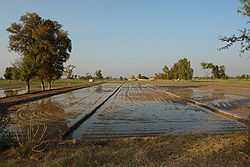
Despite lack of a coastline, Punjab is the most industrialized province of Pakistan; its manufacturing industries produce textiles, sports goods, Heavy machinery, electrical appliances, surgical instruments, Cement, Vehicles, Auto Parts, I.T, metals, Sugar mill plants,Aircraft, Cement Plants, Agriculture Machinery, bicycles and rickshaws, floor coverings, and processed foods. In 2003, the province manufactured 90% of the paper and paper boards, 71% of the fertilizers, 69% of the sugar and 40% of the cement of Pakistan.[38]


Despite its tropical wet and dry climate, extensive irrigation makes it a rich agricultural region. Its canal-irrigation system established by the British is the largest in the world. Wheat and cotton are the largest crops. Other crops include rice, sugarcane, millet, corn, oilseeds, pulses, vegetables, and fruits such as kinoo. Livestock and poultry production are also important. Despite past animosities, the rural masses in Punjab's farms continue to use the Hindu calendar for planting and harvesting.
Punjab contributes about 76% to annual food grain production in the country. Cotton and rice are important crops. They are the cash crops that contribute substantially to the national exchequer. Attaining self-sufficiency in agriculture has shifted the focus of the strategies towards small and medium farming, stress on barani areas, farms-to-market roads, electrification for tube-wells and control of water logging and salinity.
Punjab has also more than 68 thousand industrial units. The small and cottage industries are in abundance. There are 39,033 small and cottage industrial units. The number of textile units is 14,820. The ginning industries are 6,778. There are 7,355 units for processing of agricultural raw materials including food and feed industries.
Lahore and Gujranwala Divisions have the largest concentration of small light engineering units. The district of Sialkot excels in sports goods, surgical instruments and cutlery goods.
Punjab is also a mineral-rich province with extensive mineral deposits of Coal, Iron, Gas, Petrol, Rock salt (with the second largest salt mine in the world), Dolomite, gypsum, and silica-sand. The Punjab Mineral Development Corporation is running over a hundreds economically viable projects. Manufacturing includes machine products, cement, plastics, and various other goods.
The incidence of poverty differs between the different regions of Punjab. With Northern and Central Punjab facing much lower levels of poverty than Western and Southern Punjab. Those living in Southern and Western Punjab are also a lot more dependant on agriculture due to lower levels of industrialisation in those regions.
As of June 2012 Pakistan's electricity problems were so severe that violent riots were taking place across Punjab. According to protesters, load shedding was depriving the cities of electricity 20–22 hours a day, causing businesses to go bust and making living extremely hard. Gujranwala, Toba Tek Singh, Faisalabad, Sialkot, Bahawalnagar and communities across Khanewal District saw widespread rioting and violence on Sunday 17 June 2012, with the houses of several members of parliament being attacked as well as the offices of regional energy suppliers Fesco, Gepco and Mepco being ransacked or attacked.[39]
Education
The literacy rate has increased greatly since independence. Punjab has the highest Human Development Index out of all of Pakistan's provinces at 0.670.[40]
| Year | Literacy Rate |
|---|---|
| 1972 | 20.7% |
| 1981 | 27.4% |
| 1998 | 46.56% |
| 2009 | 59.6% |
This is a chart of the education market of Punjab estimated by the government in 1998.
| Qualification | Urban | Rural | Total | Enrolment Ratio(%) |
|---|---|---|---|---|
| — | 23,019,025 | 50,602,265 | 73,621,290 | — |
| Below Primary | 3,356,173 | 11,598,039 | 14,954,212 | 100.00 |
| Primary | 6,205,929 | 18,039,707 | 24,245,636 | 79.68 |
| Middle | 5,140,148 | 10,818,764 | 15,958,912 | 46.75 |
| Matriculation | 4,624,522 | 7,119,738 | 11,744,260 | 25.07 |
| Intermediate | 1,862,239 | 1,821,681 | 3,683,920 | 9.12 |
| BA, BSc... degrees | 110,491 | 96,144 | 206,635 | 4.12 |
| MA, MSc... degrees | 1,226,914 | 764,094 | 1,991,008 | 3.84 |
| Diploma, Certificate... | 418,946 | 222,649 | 641,595 | 1.13 |
| Other qualifications | 73,663 | 121,449 | 195,112 | 0.26 |
Public universities

- COMSATS Institute of Information Technology, Lahore
- Allama Iqbal Medical College, Lahore
 University of the Punjab
University of the Punjab - Bahauddin Zakariya University, Multan
 King Edward Medical University, Lahore
King Edward Medical University, Lahore - Fatima Jinnah Women University, Rawalpindi
- Government College University, Lahore
- Government College University, Faisalabad
- The Islamia University of Bahawalpur, Bahawalpur
- Kinnaird College for Women, Lahore
- King Edward Medical College, Lahore
- Lahore College for Women University, Lahore
- Lahore College for Women University, Jhang campus
- National College of Arts, Lahore
- National Textile University, Faisalabad
- University of Agriculture, Faisalabad
- University of Arid Agriculture, Rawalpindi
- University of Education, Lahore
- University of Engineering and Technology, Lahore, Faisalabad
- University of Engineering and Technology, Taxila
- University of Engineering and Technology, Taxila (Chakwal Campus)
- University of Health Sciences, Lahore
- University of Gujrat, Gujrat
- University of the Punjab, Lahore, Gujranwala
- University of Sargodha, Sargodha
- University of Veterinary and Animal Sciences, Lahore
- Virtual University of Pakistan, Lahore
- Ghazi University D.G.Khan, D.G.Khan
Private universities
- Hajvery University, Lahore
- Beaconhouse National University, Lahore
- Forman Christian College, Lahore
- GIFT University, Gujranwala
- Imperial College of Business Studies, Lahore
- Institute of Management Sciences, Lahore, Pak-AIMS, Lahore
- Lahore School of Economics, Lahore
- Lahore University of Management Sciences, Lahore
- Minhaj International University,
- University of Management and Technology, Lahore
- University of Central Punjab, Lahore
- University of Faisalabad, Faisalabad
- University of Lahore, Lahore
- University of South Asia, Lahore
- University College Lahore, Lahore
- National University of Computer & Emerging Sciences, Lahore
- University of Health Sciences, Lahore
- Akhuwat University, Dera Ghazi Khan
- Swidish University, Rahim Yar Khan
Culture

Punjab has been the cradle of civilization since times immemorial. The ruins of Harappa show an advanced urban culture that flourished over 8000 years ago. Taxila, another historic landmark also stands out as a proof of the achievements of the area in learning, arts and crafts. The ancient Hindu Katasraj temple and the Salt Range temples are regaining attention and much-needed repair.
The structure of a mosque is simple and it expresses openness. Calligraphic inscriptions from the Quran decorate mosques and mausoleums in Punjab. The inscriptions on bricks and tiles of the mausoleum of Shah Rukn-e-Alam (1320 AD) at Multan are outstanding specimens of architectural calligraphy. The earliest existing building in South Asia with enamelled tile-work is the tomb of Shah Yusuf Gardezi (1150 AD) at Multan. A specimen of the sixteenth century tile-work at Lahore is the tomb of Sheikh Musa Ahangar, with its brilliant blue dome. The tile-work of Emperor Shah Jahan is of a richer and more elaborate nature. The pictured wall of Lahore Fort is the last line in the tile-work in the entire world.
Fairs and festivals
The culture of Punjab derives its basis from the institution of Sufi saints. The Sufi saints spread Islam and preached and lived the Muslim way of life. People have festivities to commemorate these traditions. The fairs and festivals of Punjab reflect the entire gamut of its folk life and cultural traditions. These mainly fall in following categories:
Religious and seasonal fairs and festivals
Religious fairs are held on special days of Islamic significance like Eid ul-Adha, Eid-ul-Fitr, Eid-e-Milad-un-Nabi, Ashura, Laylat al-Qadr and Jumu'ah-tul-Wida. The main activities on these special occasions are confined to congregational prayers and rituals. Melas are also held to mark these occasions.
Devotional fairs (Urs)

The fairs held at the shrines of Sufi saints are called urs. They generally mark the death anniversary of the saint. On these occasions devotees assemble in large numbers and pay homage to the memory of the saint. Soul inspiring music is played and devotees dance in ecstasy. The music on these occasions is essentially folk and appealing. It forms a part of the folk music through mystic messages. The most important urs are: urs of Data Ganj Buksh at Lahore, urs of Hazrat Sultan Bahu at Jhang, urs of Hazrat Shah Jewna at Jhang, urs of Hazrat Mian Mir at Lahore, urs of Baba Farid Ganj Shakar at Pakpattan, urs of Hazrat Bahaudin Zakria at Multan, urs of Sakhi Sarwar Sultan at Dera Ghazi Khan, urs of Shah Hussain at Lahore, urs of Hazrat Bulleh Shah at Kasur, urs of Hazrat Imam Bari (Bari Shah Latif) at Rawalpindi-Islamabad and urs of Shah Inayar Qadri (the murrshad of Bulleh Shah) in Lahore.
A big fair/mela is organized at Jandiala Sher Khan in district Sheikhupura on the Mausoleum of Syed Waris Shah who is the most loved Sufi poet of Punjab due to his claasic work known as Heer Ranjha. The shrine of Heer Ranjha in Jhang has been one of the most visited shrines in Punjab.

Industrial and commercial fairs
Exhibitions and Annual Horse Shows in all Districts and National Horse and Cattle Show at Lahore are held with the official patronage. National Horse and Cattle Show at Lahore is the biggest festival where sports, exhibitions, and livestock competitions are held. It not only encourages and patronizes agricultural products and livestock through the exhibitions of agricultural products and cattle but is also a colourful documentary on the rich cultural heritage of the Province with its strong rural roots.
Other festivals
In addition to the religious festivals, Sikh Punjabis may celebrate seasonal and harvest festivals, which include Lohri,[43] Vaisakhi, while Hindus celebrate Basant and Teej.
Arts and crafts
The crafts in the Punjab are of two types: the crafts produced in the rural areas and the royal crafts.
Major attractions

The province is home to many well known historical sites including the Shalimar Gardens, Lahore Fort, the Badshahi Mosque, Rohtas Fort and the ruins of the ancient city of Harrapa. The Anarkali Market and Jahangir's Tomb are prominent in the city of Lahore as is the Lahore Museum, while the ancient city of Taxila in the northwest was once a major centre of Buddhist and Hindu influence. Many important Sikh shrines are in the Pakistani portion of Punjab, including the birthplace of the first Guru: Guru Nanak (born at Nankana Sahib). There is also the largest salt mine in Asia situated the Khewra Salt Mines.Khewra salt mines is an attraction for visitors accompanied by guides due to the fact that the mines itself is very large and complex interconnected pass ways are like a maze.There is a small but beautiful Mosque inside the mines made from salt stone.The mines have a good reputation with the patients of Asthma as breathing inside the mines help to permanently cure the Asthma and some other diseases related to respiratory system. There are few famous hill stations in the province include Murree, Bhurban, Patriata and Fort Munro.
Music and dance

Classical music forms, such as Hindustani classical music, are an important part of the cultural wealth of the Punjab. The Muslim musicians have contributed a large number of ragas to the repository of classical music. The most common instruments used are the Tabla and Harmonium.
Among the Punjabi poets, the names of Sultan Bahu, Bulleh Shah, Mian Muhammad Baksh, and Waris Shah and folk singers like Inayat Hussain Bhatti and Tufail Niazi, Alam Lohar, Sain Marna, Mansoor Malangi, Allah Ditta Lona wala, Talib Hussain Dard, Attaullah Khan Essa Khailwi, Gamoo Tahliwala, Mamzoo Gha-lla, Akbar Jat, Arif Lohar, Ahmad Nawaz Cheena and Hamid Ali Bela are well-known. In the composition of classical ragas, there are such masters as Malika-i-Mauseequi (Queen of Music) Roshan Ara Begum, Ustad Amanat Ali Khan, Salamat Ali Khan and Ustad Fateh Ali Khan. Alam Lohar has made significant contributions to folklore and Punjabi literature, by being a very influential Punjabi folk singer from 1930 until 1979.
For the popular taste however, light music, particularly Ghazals and folk songs, which have an appeal of their own, the names of Mehdi Hassan, Ghulam Ali, Nur Jehan, Malika Pukhraj, Farida Khanum, Roshen Ara Begum, and Nusrat Fateh Ali Khan are well-known. Folk songs and dances of the Punjab reflect a wide range of moods: the rains, sowing and harvesting seasons. Luddi, Bhangra and Sammi depict the joy of living. Love legends of Heer Ranjha, Mirza Sahiban, Sohni Mahenwal and Saiful Mulk are sung in different styles.
For the most popular music from the region, bhangra, the names of Abrar-Ul-Haq, Arif Lohar, Attaullah Khan Essa Khailwi, Jawad Ahmed, Legacy, and Malkoo are renowned.
Folklore

The folk heritage of the Punjab is the traditional urge of thousands of years of its history. While Urdu is the official language of the province, there are a number of local dialects through which the people communicate. These include Majhi, Jhangochi, Pothohari, Saraiki, Jatki, Hindko, Chhachhi, Doabi, and Derewali. The songs, ballads, epics and romances are generally written and sung in these dialects.
There are a number of folk tales that are popular in different parts of the Punjab. These are the folk tales of Mirza Sahiban, Sayful Muluk, Yusuf Zulekha, Heer Ranjha, Sohni Mahiwal, Dulla Bhatti, and Sassi Punnun. The mystic folk songs include the Kafees of Khwaja Farid in Saraiki, Punjabi and the Shalooks by Baba Farid. They also include Baits, Dohas, Lohris, Sehra, and Jugni.[44]
The most famous of the romantic love songs are Mayhiah, Dhola and Boliyan. Punjabi romantic dances include Dharees, Dhamaal, Bhangra, Giddha, Dhola, and Sammi.
Social issues
One social/educational issue is the status of Punjabi language. According to Dr. Manzur Ejaz, "In Central Punjab, Punjabi is neither an official language of the province nor it is used as medium of education at any level. There are only two daily newspapers published in Punjabi in the Central areas of Punjab. Only a few monthly literary magazines constitute Punjabi press in Pakistan". Many have called for the Punjabi language to be given recognition as it has in India.[45]
Notable people
- Qamar Zaman Kaira, former Minister (Pakistan Peoples Party)
- Aitzaz Ahsan, advocate (Pakistan Peoples Party)
- Muhammad Zafarullah Khan (1893–1985), politician, diplomat, international jurist
- Chaudhry Muhammad Sarwar Khan, longest serving parliamentarian of Pakistan from 1951 to 1999
- Ibn-e-Insha, poet, writer (travelogues, humor)
- Chaudhry Afzal Haq, writer, politician
- Prithviraj Kapoor, theatre and film actor
- Malik Allahyar Khan (1927–2007), former member of parliament
- Amir Mohammad Khan, Nawab of Kalabagh, Governor of East Pakistan
- Malik Ata Muhammad Khan, feudal lord
- Agha Shorish Kashmiri, witer, leaderof Majlis-e-Ahrar-ul-Islam
- Muhammad Khan, army colonel, writer, columnist
- Fazal Ilahi Chaudhry, former President of Pakistan (PPP)
- Jamshed Dasti, member of the National Assembly of Pakistan
- Shah Hussain, Sufi saint (1538–1599)
- Ajaz Akhtar, cricketer
- Shoaib Akhtar, cricketer
- Abdul Razzaq, cricketer
- Wasim Akram, cricketer and sports presenter
- Waris Shah, Sufi poet, mystic philosopher
- Chaudhry Niaz Ali Khan, landowner, agriculturalist, philanthropist, civil engineer
- Faiz Ahmad Faiz, poet
- Chaudhry Shujaat Hussain, former Prime Minister of Pakistan, current president of PML(Q)
- Chaudhry Pervaiz Elahi, first Deputy Prime Minister of Pakistan, former Chief Minister of Punjab (2002–2007)
- Nur Khan, Air Chief Marshal who participated in the military government of Pakistan from 1965-1969
- Muhammad Sarwar, recipient of the Nishan-e-Haider (NH)
- Raja Aziz Bhatti, recipient of NH
- Muhammad Akram, recipient of NH
- Shabbir Sharif, recipient of NH
- Sawar Muhammad Hussain, recipient of NH
- Muhammad Mahfuz, recipient of NH
- Alam Lohar, folk singer
- Arif Lohar, folk singer (son of Alam Lohar)
- Abdul Hafeez Kardar, cricketer
- Abdus Salam, physicist and Nobel Prize winner
- Inzamam-ul-Haq, cricketer
- Imran Khan, chairman PTI, cricketer, politician and philanthropist
- Nawabzada Nasrullah Khan, politician
- Zulfiqar Ali Khosa, politician, former Governor of Punjab
- Nusrat Fateh Ali Khan, Qawwali singer
- Mian Mir, saint revered by Sikhs and Muslims
- Sultan Rahi, actor
- Saeed Khan Rangeela, actor, comedian
- Nawaz Sharif, current Prime Minister of Pakistan
- Shahbaz Sharif, current Chief Minister of Punjab province
- Abdul Latif Khalid Cheema, politician, religious figure
- Waqar Younis, cricketer and sports presenter
- Javed Hashmi, politician PTI
- Shah Mehmood Qureshi, politician PTI
- Mirza Aziz Akbar Baig, lawyer, former Vice Chairman of Pakistan Bar Council
- Ishaq Khan Khakwani, politician
- Atif Aslam, pop singer and film actor
- Yousaf Raza Gillani, former Prime Minister of Pakistan (Pakistan Peoples Party)
- Shahnaz Sheikh, hockey player*Muhammad Rafiq Tarar, former President of Pakistan
- Bhagat Singh, revolutionary (1907–1931)
- Muhammad Zia-ul-Haq, former Army Chief of Staff and former President of Pakistan (1977–1988)
- Manmohan Singh, current Prime Minister of India
- Muhammad Tahir-ul-Qadri, scholar, politician, orator
- Shoaib Malik, cricketer
- Noor Jehan, singer and actress
Gallery
-

Lahore Fort, a UNESCO World Heritage Site
-
Jungle in Sahiwal, Punjab
-
Badshahi Mosque, Lahore
-

Wazir Khan Mosque, Lahore
-

Tomb of Jahangir, Lahore
-

Asaf Khan's Mausoleum
-

Faisalabad Clock Tower, built during the British Raj
-

Minar e Pakistan
-

GPO, Lahore
-

Railway station of Rawalpindi
-

CMH Mosque, Jhelum Cantt
-

Taxila is a World Heritage Site
-

Clock Tower at Govt College University, Lahore
-
Government college for Women, Rawalpindi
-

Major Akram Memorial, Jhelum
-

Wheat Fields
-

A view of Murree, a famous hill station of Punjab
-

Different shapes of clay pots mostly made in Gujrat
-
A Fields View from North Punjab
See also
Notes
- ↑ Industrial Zone Punjab, Pakistan
- ↑ 2.0 2.1 "Punjab – World Gazetteer". Archived from the original on 10 December 2012. Retrieved 29 March 2012.
- ↑ "Provincial Assembly – Punjab".
- ↑ Ian S Livingston; Micheal O'Hanlon (29 November 2011). "Pakistan Index" (PDF). Brookings. Retrieved 8 February 2012.
- ↑ The Growing Threat In Pakistan’s Punjab
- ↑
- ↑ Lahore Cantonment
- ↑ Singh, Pritam (2008). Federalism, Nationalism and Development: India and the Punjab Economy. London; New York: Routledge. p. 3. ISBN 0-415-45666-5.
- ↑ "How to obtain a police certificate – India". Cic.gc.ca. 2009-11-09. Retrieved 2010-07-18.
- ↑ WHKMLA: History of West Punjab
- ↑ The Languages of Pakistan
- ↑ Gazetteer of the Bombay Presidency ... – Google Books
- ↑ Gazetteer of the Bombay Presidency ..., Volume 1, Part 1-page-11
- ↑ Punjab History – history of Punjab
- ↑ Advanced Study in the History of Modern India: 1707 - 1813 - Jaswant Lal Mehta - Google Books. Books.google.co.in. Retrieved on 2013-07-12.
- ↑ Roy, Kaushik. India's Historic Battles: From Alexander the Great to Kargil. Permanent Black, India. pp. 80–1. ISBN 978-81-7824-109-8.
- ↑ Elphinstone, Mountstuart (1841). History of India. John Murray, Albermarle Street. p. 276.
- ↑ For a detailed account of the battle fought, see Chapter VI of The Fall of the Moghul Empire of Hindustan by H. G. Keene.
- ↑ Dube, I. &. S. (2009). From ancient to modern: Religion, power, and community in india hardcover. Oxford University Press.
- ↑ The Punjab in 1920s – A Case study of Muslims, Zarina Salamat, Royal Book Company, Karachi, 1997. table 45, pp. 136. ISBN 969-407-230-1
- ↑ Panel 33 European Association for South Asian Studies
- ↑ Pakistan: a modern history, Ian Talbot, St. Martin's Press, 1999. ISBN 0-312-21606-8
- ↑ "Mercury drops to freezing point – Dawn Pakistan".
- ↑ http://punjabgovt.nic.in/punjabataglance/SomeFacts.htm
- ↑ http://www.statpak.gov.pk/depts/pco/statistics/pop_by_province/pop_by_province.html_Pages/statpak.gov.pk/depts/pco/statistics/pop_by_province/pop_by_province
- ↑ Population shoots up by 47 percent since 1998. Thenews.com.pk. Retrieved on 2013-07-12.
- ↑ Muslim peoples: a world ethnographic survey / Richard V. Weekes, editor-in-chief Greenwood Press 1978
- ↑ Punjabi Muslalman by J M Wikely
- ↑ POPULATION CY RELIGION
- ↑ "Quick Stats | Punjab Portal". Punjab.gov.pk. 2014-01-16. Retrieved 2014-01-28.
- ↑ "Government of Punjab – Districts".
- ↑ (English) Internet Edition, Dawn Newspaper. "Nankana becomes district". Retrieved 2006-04-14.
No data is yet available on the recently-created district of Nankana. - ↑ "Pakistan: Largest cities and towns and statistics of their population". Retrieved 2011-02-10.
- ↑ World Bank Document
- ↑ "Provincial Accounts of Pakistan: Methodology and Estimates 1973–2000".
- ↑ http://www.thenews.com.pk/daily_detail.asp?id=152370
- ↑ – Last Paragraph
- ↑ "Punjab Gateway".
- ↑ "Another day of outrage at outages across Punjab". Dawn (Karachi, Pakistan). 18 June 2012. Archived from the original on 18 June 2012. Retrieved 18 June 2012.
- ↑
- ↑ Pakistan: where and who are the world's illiterates?; Background paper for the Education for all global monitoring report 2006: literacy for life; 2005
- ↑ The Express Tribune: Rural women uphold Pakistan’s literacy rate
- ↑ Harvest Festival of Punjab,Harvest Festival Lohri,Cultural Festival of India,Harvest Festival in India
- ↑ at Punjabilok.com
- ↑ The Punjabi Language | The Realm Of The Intoxicated Mind
External links
| Find more about Punjab, Pakistan at Wikipedia's sister projects | |
| |
Definitions and translations from Wiktionary |
| |
Media from Commons |
| |
Quotations from Wikiquote |
| |
Source texts from Wikisource |
| |
Textbooks from Wikibooks |
| |
Travel guide from Wikivoyage |
| |
Learning resources from Wikiversity |
| Wikimedia Commons has media related to Punjab (Pakistan). |
- Government of Punjab, Pakistan
- Punjab, Pakistan on the Open Directory Project
- Guide of Punjab
 |
Khyber Pakhtunkhwa Federally Administered Tribal Areas |
Islamabad Capital Territory | Azad Kashmir Jammu and Kashmir, |
 |
| Balochistan | |
Punjab, | ||
| ||||
| | ||||
| Sindh | Rajasthan, |
| ||||||||||||||||||||
| |||||||
| |||||||||||||||||
| |||||||||||


